FIRST METHODIST EPISCOPAL CHURCH
The first Methodist sermon ever preached on Iowa soil was by Rev. Barton
Randall, in what is now the city of Dubuque, November i6, 1833. This sermon
was preached at Harrison's Tavern in the village of Dubuque in Iowa territory.
The next year a class was organized and the erection of a church was begun.
In the hospital tent of the garrison, at Fort Dodge, in the fall of 185 1, gath-
ered the first congregation to hear the word of God in this place. The tent was
pitched just west of where James B. Williams afterwards lived. The congregation
consisted principally of soldiers, a few carpenters in the employ of the post, and
a few trappers and frontiersmen. The meeting lasted three days and was con-
ducted by Rev. J. A. Burleigh, a Methodist minister, who afterwards became a
member of the Des Moines conference.
The first society organized in the territory embracing Fort Dodge was called
"Webster Alission," of which Rev. Richard Clagg was the preacher in charge.
The first record of its meetings was that of a quarterly meeting held in Homer,
December 23, 1854. Rev. Wm. Simpson being the presiding elder and P. R.
Detrick, recording steward. There were three appointments named in the min-
utes: "Tolman's class," "Eckerson's class," and "Homer." At the next quarterly
meeting held at Border Plains, March 19, 1855, Fort Dodge class puts in an
appearance and pays fifty cents toward the support of the pastor and presiding
elder. At that quarterly meeting the following resolution was passed:
"Resolved, That we will assist the preacher in charge to sustain and carry out
the doctrine of the Discipline on the subject of Temperance."
This quarterly conference also inaugurated a plan and appointed trustees for
the erection of a church building at Homer. P. R. Detrick, D. A. Eckerson, W.
T. Woolsey, Theodore Eslick, Levi Allen and John Tolman were elected the
trustees.
Webster Circuit was organized out of Webster Mission, and held its first
181
182 HISTORY OF WEBSTER COUNTY
quarterly conference at Boone schoolhouse, on Boone river December 8, 1855,
Rev. Daniel L. Abbott being pastor; Samuel Hayden presiding elder, and Will-
iam Clearage, junior preacher. From that date the list of pastors is as follows:
In 1856, Rev. J. Parker; 1857, Rev. C. H. Lawton, and Rev. David P. Day; 1858,
Rev. C. H. Lawton. Rev. J. M. Rankin was presiding elder during all these years.
At this conference the following resolution was recorded:
"Resolved, that vigorous efforts be made at once to enlarge the subscription,
and if possible to proceed in the spring to build a ^Methodist church in Fort
Dodge."
S. B. Ayers, John Parsons and the pastor were appointed to estimate the cost
of the proposed church.
Prior to this services were held in the brick schoolhouse. Rev. S. B. Guiber-
son, the pastor, was sent east to raise money, but though gone almost the whole
year had little success. By persistent effort and liberality on the part of the
public, however, the church was built, being the first one in the city. It was a
large roomy building, and its erection was a creditable work for the young society.
The shingles on this building were oak, and were split by hand by Isaac Garmoe.
At this time the circuit was again divided and the Fort Dodge circuit organ-
ized. This circuit extended along the Des Moines valley, embracing Dayton on
the south, and Algona on the north. Its list of pastors is as follows; 1859-60.
Rev. B. Holcomb; 1861, Rev. Thomas Thompson; 1862-63, Rev. H. S. Church;
1864, Rev. S. W. Ingham. Rev. Joel B. Taylor was the presiding elder during
these years. At this period came another change and Fort Dodge Station was
organized, with the following pastors for ten years, 1865, Rev. W. A. Richards;
1866, Rev. C. W. Batchellor; 1867, Rev. C. C. Mabee; 1868, Rev. William E.
Smith; 1869, Rev. J. M. Robinson: 1870-71. Rev. W. F. Morrison; 1873. Rev.
T. M. Williams; 1873-74, Rev. J. H. Lozier. The presiding eiders for this period
were Rev. D. Lamont, Rev. T. M. Williams, and Rev. J. W. Todd.
Under Rev. Lozier's pastorate, the church membership largely increased and
the need of a new church w-as apparent. At a session of the quarterly confer-
ence held May 15, 1873, this matter was up for discussion, and a committee was
appointed to formulate church building plans. This committee consisted of E.
E. Prusia, Isaac Garmoe, D. M. Crosby, D. A. Weller, John F. Duncombe, N. M.
Page, G. R. Pearsons and F. M. Grant. The committee at once began the work
of raising money by subscription. Within two months they had raised two
thousand dollars. With this amount in sight, the trustees of the church decided
to go ahead with the building, and Isaac Garmoe, E. E. Prusia, D. M. Crosby,
G. R. Pearsons, N. M. Page and F. M. Grant were appointed a building com-
mittee, with Mr. Pearsons as chairman.
At a session of the board of trustees January 8, 1874, plans were submitted
for the new building. Those of Mr. A. V. Lambert were finally accepted and
he was chosen architect, with instructions to furnish designs and specifications
for a church edifice to cost not less than fifteen nor more than twenty-five thou-
sand dollars. The work of excavation was commenced at once, and the founda-
tions were laid by Patrick O'Conner.
The corner stone was laid September 15, 1874. The ceremony was in charge
of the Masonic societies, assisted by the Odd Fellows. The exercises were com-
menced with a prayer by Rev. J. ff. Burleigh, who preached the first sermon
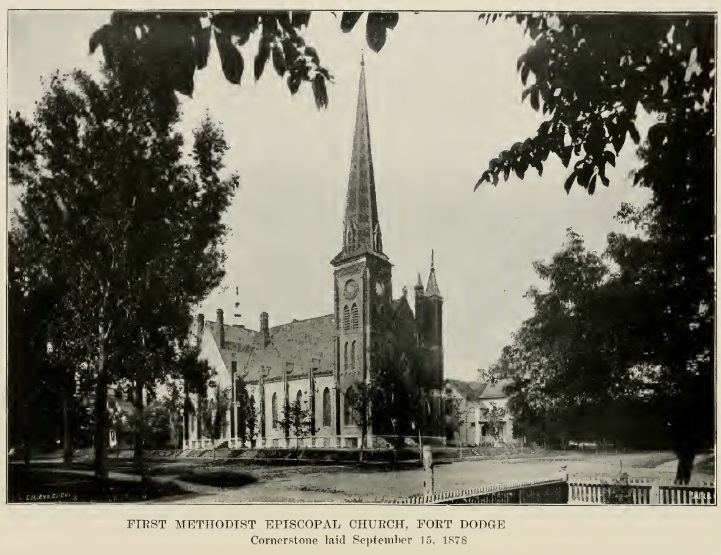
HISTORY OF WEBSTER COUNTY 183
in Fort Dodge. An address of welcome was made by Mr. J. M. Berry, chairman
of the board of trustees, and responded to by Gov. C. C Carpenter. This was'
followed by an original poem by Mr. Woolsey Welles.
The work on the church was carried on during the balance of the fall and win-
ter. Messrs. Mitchell and Sulzbach had the contract for the brick work, and
Mr. Israel Jenkins had the supervision of the structure. The church was first
occupied for services in August, 1875. although the building was not yet completed.
Lack of funds made it necessary to postpone the completion of the building.
Rev. J. A. Potter, was at this time appointed pastor, and served for one year.
He was succeeded by Rev. H. T. Curl, who in turn was succeeded by Rex. I. N.
Pardee. Under his pastorate the church building was completed and formally
dedicated, June 3, 1878. The building cost about twenty-two thousand dollars.
The parsonage was built in 1893 and cost about three thousand dollars.
Since Rev. Pardee, the pastors have been: Rev. Henry W. Jones, Rev. George
C. Haddock, who was later murdered in Sioux City on account of his activity in
the temperance movement. Rev. L. H. Woodworth, Rev. J. N. Liscomb, Rev. J.
W. Southwell, Rev. J. H. Avery, Rev. George Kennedy, Rev. Robert Smiley.
Rev. A. S. Cochran, Rev. G. W. Pratt. Rev. George C. Fort, and Rev. W. H.
Spence.
ST MARK'S EPISCOPAL CHURCH
St. Mark's Episcopal church was organized at a meeting of the citizens called
together by the Rev. Mr. Peet, rector of ,St. Paul's church, Des Moines. This
meeting was held and organization effected on July 22, 1855.
The first work of the congregation was to get a church building. Just one
year after the organization, (July 1856), Bishop Lee offered to raise the remain-
ing funds necessary for a chapel, providing $1,000.00 were raised in Fort Dodge.
This offer was not accepted, but on February 17, 1858, the vestry resolved to build
a church during the ensuing summer. Mr. J. L. Cheney, Mr. E. Bagg, and Dr.
S. B. Olney were appointed the building committee. This building was a frame
structure and stood just north of where Tobin College now stands.
On account of the "hard times'' of the panic of 1857, and also the Civil war
ensuing, the building was not completed until 1873-76. This was made possible
through the generosity of J. F. Duncombe, Webb Vincent, Beth Vincent, B.
Grayson, H. Beecher and Dr. S. B. Olney. The church was consecrated by the
Rt. Rev. H. B. Whipple, D. D., bishop of Minnesota, on June 28, 1876.
. January 5, 1892. the church was destroyed by fire. Steps were immediately
taken for the erection of a new structure. The vestry headed by the Rev. J. W.
Paige and Mr. Leon Vincent were appointed as the building committee. Rev.
Paige died in the early spring of 1893. On April 23, 1893, the vestrv appointed
Messrs. J. C. Cheney, Web Vincent, Leon Vincent and A. J. Arthur as a new
building committee. On May 24. 1894, Mv. C. B. Hepler presented a proposal
to build the new church for the sum of $7,000.00. This was accepted and the
building erected. In 1898 the chancel was enlarged and a new organ installed
at a cost of $2,683.00.
THE RECTORS
Rev. Mr. Peet who initiated the organization of the church in 1855 and during
the war conducted occasional services.
184 HISTORY OF WEBSTER COUNTY
The Rev. T. B. Fairchild called to the rectorship December 19, 1857. He
remained a little more than one year.
Rev. Samuel Goodale called in the spring of i860; resigned at the end of
a year.
On October 1, 1866, the Rev. John Hochuly became rector; leaving January
I, 1868.
From January 1, to Easter of 1870, there was no rector, then the Rev. E. H.
Harlow, was called. He left after a service of something more than a year.
Rev. Harlow was succeeded by Rev. B. R. Phelps who left early in 1873.
On June 24, 1873, Rev. Charles T. Stout became the rector. He appears to
have been an energetic worker, wiping out the debt on the church of $2,200.00.
During his stay the church was consecrated. He resigned to take effect July
24, 1876.
Rev. W. C. Mills of Ottumwa, immediately followed; he resigned to take
effect August 1, 1880.
There was no rector until April, 1882, when the Rev. C. C. Adams was
called. Rev. Adams resigned to take effect April 1, 1883.
May 7, 1883, Rev. P. C. Wolcott was called; he resigned to take effective May
1, 1884.
On March 2/, 1885, the Rev. Robert J. Walker was called and resigned within
a year.
On April 25, 1888, Rev. J. W. Paige of Sharon Springs, N. Y., became rector.
This faithful servant died March 31, 1893, and is buried in Oakland cemetery,
Fort Dodge.
Rev. Paige was succeeded after nearly two years by the Rev. A. V. Gorrell
who resigned at the end of nine months.
On April 19, 1897, the Rev. C. H. Remington was called and became rector.
He was a man of large visions and had a personality that is felt to this day.
Ill health compelled his resignation in December, 1905.
The Rev. Charles Lewis Biggs became rector on January 8, 1905. He resigned
to take charge of a larger parish in Henderson, Ky.
The present rector is Rev. F. E. Drake.
THE FIRST CONGREGATIONAL CHURCH OF FORT DODGE
THE FIRST CONGREGATIONAL CHURCH OF FORT DODGE
The First Congregational church was founded February 29, 1856. On that
date Mr. and Mrs. William Plumb, Mr. and Mrs. D. A. Haviland, and Mr. and
Mrs. A. J. Haviland met at the home of William Plumb, who then lived in one of
the houses of the old fort, and perfected an organization. Officers were elected as
follows: William Plumb, clerk; A. J. Haviland, treasurer; D. A. Haviland,
deacon.
The following Sunday services were held at the old schoolhouse just back
of where the Wahkonsa school building now stands. Rev. T. N. Skinner, a mis-
sionary with headquarters at Webster City, met with them and preached their
first sermon. At this meeting they celebrated their first communion service. Rev.
Skinner supplied the new church until spring, when Rev. William Kent, the first
pastor, came from Waterloo. He served but a short time. Up to 1864 there was
no regular pastor, but the church missionaries looked after the needs of the
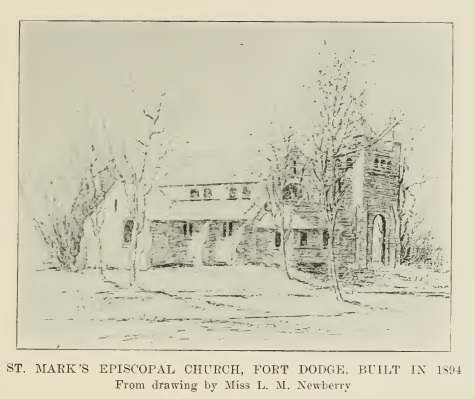
HISTORY OF WEBSTER COUNTY 185
church. The well beloved Father Taylor, the "Bishop of Iowa" ministered fre-
quently to them.
In 1864, Rev. H. E. Boardman, came as the first permanent pastor. The year
book for 1865 gives the following data: members, nineteen; received during the
year, seven by letter and five on profession of faith; one dismissed, and one
absent. One baby baptized; one adult baptized; eighty in the congregation; forty-
five in Sunday school; benevolent contributions $32.00. In the year 1866, the
Congregationalists formed a partnership with the Presbyterians, services being
held in the Presbyterian church. During this year also Rev. Boardman resigned,
and Rev. C. F. Boynton began his ministry and remained until 1868, when Rev.
Phillips came. However, Rev. Phillips was pastor but a short time, ill health
forcing him to give up the work. For a year the church was, without a pastor, and
they continued to meet with the Presbyterians. A meeting was held, May 29,
1869, and the decision was reached that the Congregationalists should form a
separate organization if Congregationalism were to be preserved. Accordingly
letters of dismission were granted to all who -wished to join other churches.
There then remained but nine Congregationalists. These nine were: George
Killam, Mr. and Mrs. L. W. Smith, Mr. and Mrs. O. P. Fuller, Mr. and Mrs.
G. S. Killam and Mr. and Mrs. G. S. Webber. At the beginning of the pastorate
of Rev. David Wirt, who was called in 1869, the following became members: Air
and Mrs. C. H. Payne, William K. Laughlin, Jr., Thomas A. Laughlin, Mr. and
Mrs. Clark Fuller, Mr. and Airs. Bronson R, Merritt and daughter. Miss Helen
R. Merritt; Rev. and Mrs. David Wirt and daughter, Aliss Julia Wirt, making
twenty^one members in all. Services were held for a while in Henry's hall, which
stood on the north side of Central avenue between Sixth and Seventh, then in
the Child's block, just south of the present courthouse, then for awhile they met
in the old Alethodist church, and then in the courtroom in the old courthouse. A
new constitution was adopted in 1869 and the following officers were elected: C.
H. Payne, deacon; O. P. Fuller, treasurer; G. S. Killam, clerk. The five trus-
tees were: Thomas Laughlin, L. W. Smith, O. P. Fuller, William K. Laughlin,
and G. S. Killam. During the same year the congregation decided to build. The
building committee were Rev. David Wirt, O. P. Fuller, G. S. Killam, G. S.
Webber. The contract for the building was let to B. D. Beach for $1,750.00.
The location chosen was the present site of the Carter building, in the middle of
the block between Tenth and Eleventh streets on the north side of Central avenue.
This building was dedicated January 23, 1870. Rev. C. F. Boynton gave the
scripture reading and prayers. The dedicatory address was made by Rev. J.
Guernsey. When the Congregationalists moved to their present location in 1887
the old building was subsequently used by the Christian church, and then by the
Salvation Army. It was a plain unpretentious brick structure, that would seat, at
the most, only about three hundred; but in the early seventies it was considered
something fine. The first baby baptized in, "the little brick church" was Perry
Page Killam. Hon. George E. Roberts, now director of the United States mint,
was at one time janitor of this church building, and the records show, that he
received a salary of one dollar for a month's labor. Rev. Wirt resigned in the
latter part of 1870, and for a year Rev. William A. Patton and Rev. Julius House
supplied the pulpit. In 1872 Rev. Thomas O. Douglas was called as pastor and
served the church for two years. He was followed by Rev. D. M. Brecken-
186 HISTORY OF WEBSTER COUNTY
ridge, who remained four years. During Rev. Breckenridge's pastorate the church
membership increased to one hundred and nineteen. In 1878 Rev. L. L. West
became pastor. During his leadership, the present church on the corner of First
avenue north and Seventh street was built. This structure cost $10,000.00, and
was dedicated January i, 1887. Rev. Thomas O. Douglas and President Will-
iam Brooks of Tabor College conducted the dedicatory exercises. Rev. West's
pastorate was the longest in the history of the church extending over a period of
twelve years. He was succeeded by Rev. E. S. Carr in 1890, who served until
1894, and was followed by Rev. E. R. Latham. Rev. Latham served three years,
and in 1897, Rev. H. D. Wiard was called, and remained until 1901. Rev. W. I.
Suckow began his pastorate in June, 1902, and continued until 1905. In that year
Rev. Reuben L. Breed came to the church and served until the fall of 1909, when
the present pastor, Rev. Nelson Wehrhan, began his work.
THE EARLY CATHOLIC CHURCH IN WEBSTER COUNTY
Prior to 1856, the spiritual wants of the few pioneer Catholics in this part
of the state were cared for by a few mission priests, who traveled the prairie
wilderness on horseback and sought out from house to house the scattered mem-
bers of that church. Among these men were the Rev. Matthias Hannon who
came overland in 1853 from the southeast.
The first priest to come to Fort Dodge as a regular pastor was Father John
Vahey who arrived in 1856. He built a little cabin to live in and started the
building of the first church, constructed from rough hewn logs. His parishioners
were few, and among those who helped cut and hew the logs were Dr. W. L.
Nicholson, Peter Reilly, William Reilly and John P. White.
Father Vahey left in 1857, and in the autumn of that year. Father McCullough
came and remained one winter. He was succeeded by Father Ellwood who
remained about two years. Then came the well beloved and gentle Father Marsh
in i860, and he remained until his untimely death in 1865. His dust and bones are
resting now in the vault in the Catholic cemetery north of the city. He knew all
the pioneers, the men, women and children, and a gentler, kindlier man never
trod the soil of the great stretch of country that constituted his parish, extending
from Fort Dodge to Emmetsburg and Spirit Lake on the north, and to Sioux
City on the west. Often in the dead of winter, he would drive with his ox team
across the prairies to minister to the needs of those in these distant parts of his
parish. Father Marsh took his axe and with some of his parishioners cut the
logs and lumber from the hillside near what is called Arnold's dam to build
the first Catholic school in Fort Dodge.
After the death of Father Marsh in 1865. Fathers Delany and Butler came and
remained until 1870. Then came Father Thomas M. Lenehan whose long and
successful pastorate is a part of the general history of the state. He remained
until 1897, when he was made Bishop of Cheyenne. Father Lenehan built the
present Corpus Christi church which was dedicated January 1, 1883. He also
built the old convent and began the construction of the present school.
Bishop Lenehan was succeeded by Father Campbell under a temporarv appoint-
ment, and in September, 1897, Rev. P. J. Burke was assigned as pastor and
remained until September, 1903.
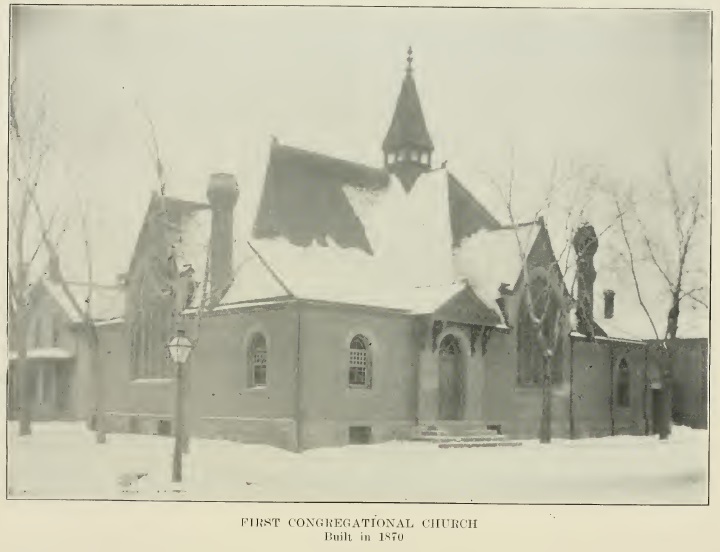
HISTORY OF WEBSTER COUNTY 187
Then came Very Rev. B. C. Lenehan, the vicar general of the Sioux City dio-
cese, whose long and faithful service as a priest earned him the honor of pro-
motion as a Monsignor in 1905. He was succeeded by Rev. James T. Saunders.
Sacred Heart Parish was established June 3, 1897, by Arch Bishop Henessy.
Father Edmond Heelan, who was at that time rector of the Cathedral at Dubuque,
was appointed to take charge of the new congregation and is still here. On July
21, 1897, work was begun on a church which cost about $4,500.CX). On Sunday,
October 24, 1897, mass was celebrated in it for the first time, and on Sunday,
November 7, 1897, the church was dedicated with solemn and appropriate
ceremonies by Monsignor Ryan and a large number of priests. Rev. R. Slattery
of New Hampton preached the dedicatory sermon at morning mass, and at the
evening service Rev. W. Halpin lectured to a large audience.
The two Fort Dodge congregations are now among the most prosperous in
tiie state. In 19 10, the Knights of Columbus erected their building on First
avenue south, and Ninth street. St. Joseph's Hospital, built in 1908, was dedi-
cated March 21, 1909, by Bishop Garrigan.
When Father T. M. Lenehan came here in 1870, there was only the little old
church now used as a chapel. Today there are two churches in Fort Dodge, two
parochial schools and residences, a fine brick church and school at Clare and
churches at Barnum, Moorland, Lehigh, Duncombe, Mncent, Coalville, and the
church on the Lizard, almost on the Pocahontas county line. The parish he had
in 1870 has now over one hundred sub-divisions and but few of his old co-laborers
of that date are living.
The soldiers left the old fort here in 1854, and fast upon the advancing and
protecting rifle came the Catholic pioneers. In 1855 came Mrs. Hannah Reilly
and family. They settled upon the north half of section thirty-three in Cooper
township and received a patent from the United States government. This patent
they held for nine years and then they were evicted. George Crilly was another
of the vanguard coming in 1855. He settled upon the quarter section of land of
which Olesori Park is now a part. He, too, had title from the government, but
lost his land, and for many years Mrs. Reilly and George Crilly fought for their
homes. Mrs. Reilly's case went to the United States supreme court and George
Crilly stormed the chambers of congress pleading for his home. They both lost
but bravely turned their faces to the future and began again. Mrs. Reilly died
here in Fort Dodge, and George Crilly died a few years ago in South Dakota.
FIRST PRESBYTERIAN CHURCH
The First Presbyterian church was organized September 22, 1856, by Rev.
S. T. Wells, a missionary. The first members were Maj. W. Williams, Jeanette
J. Williams, Samuel Rees, Eleanor Rees, and Andrew Miller. The first minister
was Rev. Edward L. Dodder. Andrew Miller and Samuel Rees were ordained
elders.
On the twenty-first of July, 1856, William Wilson, Jr., of Philadelphia, of the
firm of Wilson, McBane & Co., drew up a subscription paper soliciting aid "to
build a Presbyterian meeting house in Fort Dodge." On September 22, 1856, the
trustees received a donation from the proprietors of the town of lot three, block
twenty-five, valued at $100.00. Money to erect a building was raised by subscrip-
188 HISTORY OF WEBSTER COUNTY
tion, and the church was completed and dedicated February 25, 1856, at a cost
of $2,207.00 As the church grew this edifice proved too small, and two lots were
secured in 1880 on the corner of First avenue south and Eighth street for
$1,600.00. Subscriptions to the amount of $10,292 were raised. Work was
begun the same year and the church was dedicated October 7, 1881, under the
pastorate of Dr. Robert F. Coyle.
During the years 1861-69, the Presbyterians and Congregationalists held union
services. The church has always been active in missionary work, and has sup-
ported a mission west of Moorland, at the Duncombe mills, and the Memorial
Chapel on the corner of Fourteenth and Tenth avenue south.
The Memorial Chapel was built by Mr. E. H. Rich in memory of his son,
Willis Rich. The following have served the church as pastors: Rev. Edward L.
Dodder, Rev. Lyman C. Gray, Rev. R. F. Coyle, Rev. Ezra B. Newcomb, Rev. j.
Milton Greene, Rev. Phil C. Baird and the present pastor, Dr. E. E. Hastings,
who has been pastor since 1908. The society when organized belonged to the
Presbytery of Dubuque, but now forms a part of the Presbytery of Fort Dodge.
THE FIRST BAPTIST CHURCH
The First Baptist church of Fort Dodge was organized June 16, 1871, by
Rev. H. D. Weaver, with ten members. Its first services were held in the old
brick schoolhouse on Second avenue south. In 1876 the congregation built a
church on the corner of Central avenue and Tenth street, where the Wahkonsa
Hotel now stands. Rev. George W. Freeman was pastor at this time. The
church was closed for several years and the congregation disbanded. In the
winter of 1892. Rev. T. S. Bovell reorganized the church, holding a series of
meetings which resulted in a number of additions to the church membership, and
also served to increase the interest. Rev. Bovell served as pastor for seven
years, and was followed by Rev. Arthur Parks, who was ordained by the church
in June, 1899. Rev. Robert Carroll succeeded Rev. Parks in 1901. During his
leadership the present church building on First avenue north and Tenth street
was erected. The dedication took place in November, 1903. The present pastor
is Rev. Alva J. Brasted.
THE CENTRAL CHURCH OF CHRIST
The Central Church of Christ was organized by Rev. A. M. Haggard, state
secretary of the Church of Christ, in November, 1895, with a membership of
forty-six, which increased to one hundred by the end of the year. The first pas-
tor was Rev. G. W. Mapes, who was followed by Rev. C. C. Davis.' For several
vears services were held in the old Congregational church. Later they secured a
lot on the corner of First avenue north and Twelfth street. During the leader-
ship of Rev. S. H. Lee, the plans for the present church structure were begun.
However, the building was not finished until the pastorate of Rev. Lewis H.
Kopp in 1909. Rev. S. R. Reynolds, the present pastor, has served the church
since 1912.
THE RIVERSIDE METHODIST CHURCH
On account of the growth of the city, it was found expedient to divide the
First Methodist church in 1892. Accordingly, the Riverside Methodist church.
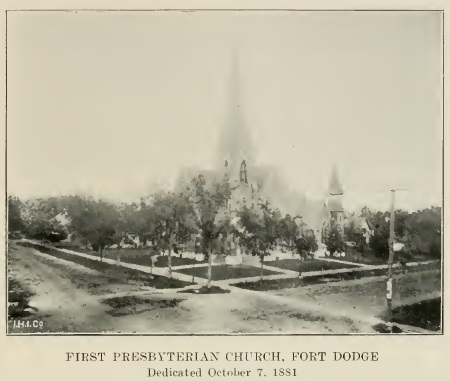
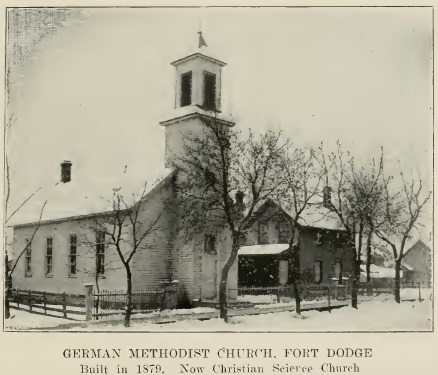
HISTORY OF WEBSTER COUNTY 189
located in West Fort Dodge, was organized and a church structure erected the
same year. Rev. C. E. Leitzell is the present pastor and also has charge of the
Epworth Methodist church, situated at the corner of Eleventh avenue south and
Twenty-first street.
CHRISTIAN SCIENCE
The Christian Science society was formed from the membership of several
classes which were taught by Mrs. Mary Philbrick, C. D. S., during the summer
of 1888. Mrs. Philbrick was a student of Mary Baker Eddy. For a number of
years the society met in various rooms and halls. For a time they met in the
Mason block, later they purchased the property of the German Methodist society
on the corner of Twelfth street and First avenue north, which constitutes their
present church building.
FIRST GERMAN METHODIST CHURCH
The First German Methodist Episcopal society was organized in 1873. At
the first services were held in private homes and halls. In 1879 a lot was pur-
chased, and a church built on the corner of First avenue north and Twelfth
street, which was afterward sold to the Christian Science church. At the present
time the church has no organization in Fort Dodge.
ST. PAUL'S GERMAN LUTHERAN CHURCH
St. Paul's German Lutheran church was organized by the Rev. F. Fikensher
in i860, with a membership of seven families. The first German sermon was
preached at the home of Mr. Lenhart Fessel, on First avenue south. In 1864,
under the leadership of Rev. Godfrey Endres, a stone church was built in which
the congregation worshiped for twenty years. The present church, on the corner
of Fourth avenue south and Thirteenth street, was dedicated in 1886. The
Sunday school was organized in 1863. The pastors have been Rev. F. Fikensher,
Rev. Godfrey Endres, Rev. J. L. Craemer, Rev. Ernest Zuerrer, and Rev. Mar-
tin J. Von der Au, who has served since 1909
190 HISTORY OF WEBSTER COUNTY
ST. OLAF's NORWEGIAN CHURCH
St. Olaf's Norwegian Lutheran church was organized September 22, 1891, by
Rev. B. K. Berkeland, with a membership of twenty. For three years services
were held in the Swedish Lutheran church. During the summer of 1893, a
movement was started for raising funds to build a new church, and plans were
drawn and accepted. In September of the same' year the foundation was laid.
The church was finished and dedicated the last Sunday in October, 1894. The
present pastor is Rev. P. C. Danielson
SWEDISH MISSION CHURCH
The Swedish Mission church is located on Avenue "B" between "K" and
"L" streets in West Fort Dodge. It was organized in 1901. The present pastor
is Rev. C. J. Andrews.
FIRST SWEDISH LUTHERAN CHURCH
May 31, 1870, a party consisting of Carl J. Johnson, Lars Sandquist, Peter
Olofson, Christian Petterson, Magnus Hof, Carl J. Petterson, Carl O. Peterson,
August Nelson, Anders Anderson, Isaac Swanson, John Johnson, John
Peter Anderson. Carl Alfred Haf. Olof Berg, Christian Person, and Olof Olof-
son met at the home of August Nelson in West Ft. Dodge and organized a Swe-
dish Lutheran church. Rev. Llokan Olson was chosen chairman of the meeting
and August Nelson, secretary. Gustaf Alstrand, while one of the promoters
of the organization was not present, but was elected a trustee at this meeting. It
was decided to affiliate with the Augustana Synod of America. Deacons and
trustees were elected, and the treasurer was instructed to raise funds and secure
a building site.
Of those who first met to organize the church only three are living today,
namely, C. O. Peterson, residing at 214 Second avenue south; August Nelson
of Dayton, Iowa, and Gustaf Alstrand, residing at 220 'T" street.
September 28, 1870, a constitution and by-laws were adopted. Services were
held whenever possible, sometimes at the homes of the members, and also in the
old brick schoolhouse that stood on Second avenue south between Seventh and
Eighth streets. Services were often held in the German Lutheran church, that
was located on Third avenue south between Fifth and Sixth streets. This build-
ing was built of gypsum stone.
In December, 1870, Hon. John F. Duncombe presented the church with two
lots located on the banks of the Des Moines river on "J" street. In 1873 a church
was built. It was twenty-four feet by thirty-four feet on the ground and four-
teen feet in height. The church was dedicated by the Rev. Hokan Olson.
In 1874 Rev. A. Philgren was called to serve as pastor of this and the church
at Manson, Iowa. A parsonage was built in 1875 or 1876. The church was incor-
porated in the early seventies, but was reincorporated in 1878. A call was
extended to Rev. C. L. Beckstrom to become a minister for the church. Rev.
Beckstrom remained eleven years, serving this congregation two-thirds of the
time. The balance of the time was given to his charge at Callender. Iowa.
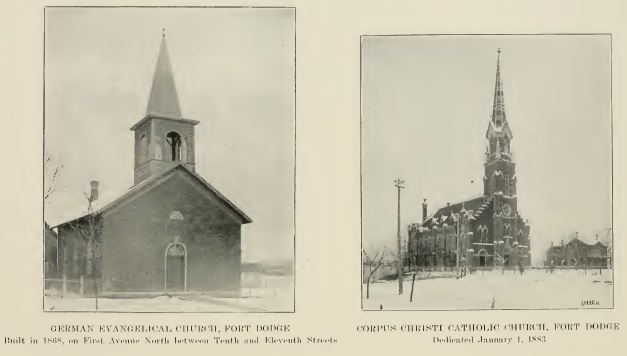
HISTORY OF WEBSTER COUNTY 191
In 1894 Rev. Kris Rosental was called to serve the congregation as pastor.
Prior to the calling of Rev. Rosenthal the congregation suffered from lack of
funds, on account of having a small membership and most of these in very
modest circumstances. During the years 1894 to 1897 there was a goodly increase
in membership. At this time, however, there arose a division of the church, a few
members favoring the acquiring of property on the east side of the Des Moines
river for the purpose of erecting a church, while the majority favored remaining
on the west side. This division had a bad effect upon the congregation, as it kept
the members in a constant state of agitation and gave rise to many an unpleasant
situation. However, this movement failed in its purpose, although the congrega-
tion suffered the loss of several members on its account. It also kept many away,
who would otherwise undoubtedly have joined.
Rev. N. T. Tuleen became pastor in 1898. In 1900, the church received all
the property belonging to Mr. and Mrs. Swan Peterson, upon the death of Mr.
Peterson. A window in the present church building is dedicated to their mem-
ory. The money realized from the sale of this property was used to pay a small
debt and the balance, about $400.00, was the beginning of a church building fund.
Rev. C. S. Renins was elected pastor in 1901, and Rev. J. A. Borgstrom in 1903.
March 15. 1904. it was decided to begin the building of a church, on a lot,
which had been purchased for that purpose on the corner of Avenue '"C and "J"
street. Gust Alstrand. William Larson, L. J. Alstrand. P. J. Swanson. Elmer H.
Swanson. Ole Rosen, Gust A. Olson. John Nelson, and August Pehrsson, were
appointed a building committee. On July 19, 1904. the president of the Iowa
Conference, Rev. A. Norrbon. laid the cornerstone of the new church.
Work on the new church progressed nicely and it was finished in 1905, and
was dedicated November 12. 1905, by Rev. Norbon. The firsL marriage ceremony
in the new church was performed September 27, 1905. when Luther J. Alstrand
and Selma Pehrsson were married. The first burial service was over the remains
of Mrs. Charlotte Vieg, one of the pioneers of Webster county.
August 2. 1906. Rev. J. A. Mattson was elected as pastor of the church. He
was followed by Dr. Emil Lund August 31. 1910.
The church celebrated its fortieth anniversary June 26, 19 10.
During the year 191 1, the congregation erected a new parsonage at a cost of
about $4,000.00. Since the year 1903, the church has made its greatest gains, many
have been admitted to membership and the progress made along financial lines
has been truly remarkable. A Sunday school was organized about 1S82. The
Ladies Aid Society counts its existence from a nuich earlier period. The Young
Peoples Society was organized about 1893, by Rev. A. Gunberg. The Busy Bee
Society was organized by Mrs. Gust Alstrand about 1898. These societies are of
inestimable value in the work. The writer has avoided as much as possible
special mention of any particular person connected with the work, as in order to
do justice to the splendid workers, and the sacrifices which they made, it would
make a volume in itself. However, the reader will jjlease pardon the one
exception in referring to Mr. Gustaf Alstrand. who is the only one retaining a
membership in the church, who was one of the original organizers. Much credit
is due to Mr. Alstrand for the work done by him, and his wife (Mrs. Sophia L.
Alstrand, who died March 21. 1911). Her devotion and interest in the cause
192 HISTORY OF WEBSTER COUNTY
never ceased until her death, and his still continues an active force in the work of
the congregation.
Dr. Emil Lund, the present pastor, is a splendid man of God, working unself-
ishly and well that the work of the church may not cease but attain a greater
state of perfection.
SWEDISH BETHLEHEM CHURCH
In 1901, a part of the congregation of the First Swedish Lutheran church,
consisting principally of the members living on the east side of the Des Moines
river, withdrew, and forming a new organization, known as the Swedish Bethle-
hem church, erected a church building on the corner of First avenue north and
Eleventh street. The building was dedicated in 1902, and Rev. C. E. Renins was
the first pastor. He was followed by Rev. G. E. Thimmell and Rev. C. A.
Carlson. The present pastor, Rev. Nels Gibson, began his pastorate in 1911.
The society has just completed building a fine parsonage at No. 4, Johnson place.
SALVATION ARMY
The Salvation Army first began work in Fort Dodge in 1891. Their first
barracks were in an old frame building on the southeast corner of First avenue
south and Sixth street. When this building was torn down the Army moved
their barracks to the old Congregational church building on Upper Central avenue
and remained there until the fall of 1912. During the time that the building was
used by the Salvation Army, it was the regular voting place for the Third ward of
Fort Dodge. When the building was torn down to make room for the Carter
building, the Army moved to their present quarters at No. 18 North Seventh
street.
SECOND BAPTIST CHURCH
The Second Baptist church (colored) has a small frame church building on
the corner of Nineteenth street and Fourth avenue south. They have no regular
pastor.
THE WEBSTER COUNTY BIBLE SOCIETY
The Webster County Bible Society is the oldest society in Webster county, still
in existence. The first meeting of the society was held October 7, 1858, and the
following ofticers were elected: William Williams, president; C. C. Carpenter,
vice president; Stephen B. Ayers, secretary; Samuel Rees. treasurer. A consti-
tution was adopted and an oflfering of $14.25 was made to the work. The fol-
lowing counties were embraced in the association: Webster. Calhoun, Humboldt,
Pocahontas. Kossuth. Palo Alto. Emmet. Sac, Buena Vista and Dickinson. A
branch society was organized at Lumpkins schoolhouse. June 30, 1865. In Janu-
ary, 1873. branches were established at Otho and Tyson's Mill.
Y. M. C. A.
The Young Men's Christian Association was organized in 1890. The first
secretarv was lohn Ruse. The second was Herbert Ward. who served but a
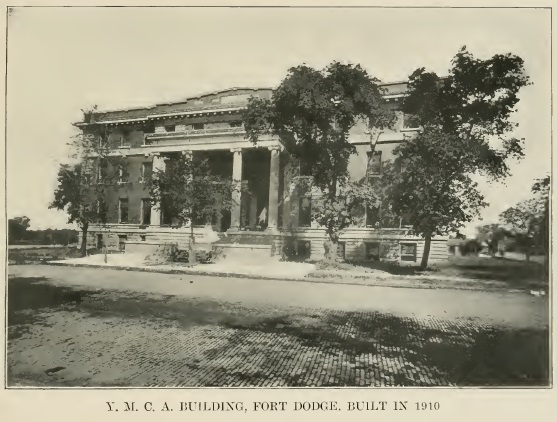
HISTORY OF WEBSTER COUNTY 193
short time, and was followed by A. W. Braily. The society was in a prosperous
condition until January 17, 1893, when the building in which the rooms were
located was destroyed by fire. This made a heavy loss as the furniture was not
insured. Mr. Charles B. Hall, a Fort Dodge boy, began the work of reorgani-
zation. Rooms were secured on the corner of Ninth and Central avenue. Mr.
Hall served as secretary until June 15. 1895, when he resigned and was succeeded
by Mr. John H. Fellingham.
In February, 1898, quarters consisting of eight large rooms were secured in
the Sanderson block and was fitted up at an expenditure of $1,600. A gymnasium
was added, January, 1899. At a large banquet held in the Armory, October 18,
1909, plans were made and subscription lists were started for a new building.
The site opposite the Carnegie library was donated by O. M. Oleson.
Work on the new building was begun in the spring of 1910, and the building
was opened February 15. 1911. It is a three-story and basement structure, and
is one of the most completely equipped Y. M. C. A. buildings in Iowa, costing
about $90,000 for the site, building and equipment.
C. D. Case is president of the board of directors. The present general secre-
tary is F. W. Mahlke, with George H. Cochburn, assistant, and J. T. Carley,
physical director.
Y. W. C. A.
The Young Woman's Christian Association was organized July 8, 1909. Mrs.
J. P. Dolliver was the first president and served until October, 1910, when she
resigned and Mrs. G. S. Ringland was elected and still holds the ofiice. The work
was conducted for a time in the frame building just north of the Commercial
National Bank building. In the fall of 1909 the Reynolds property on the cor-
ner of First avenue north and Ninth street was purchased, and became the asso-
ciation home. At the time of buying the location, $13,000.00 of the purchase price
was raised by subscriptions, of which $10,000.00 was paid for the site. Later the
lot adjoining on the west was purchased at a cost of $4,500.00. To do this, it
was necessary to place a mortgage of $1,500.00 on the lot. The last payment
on this mortgage was made January 17, 191 3. The event was celebrated on
the twenty-first of the same month by a large banquet at which covers were
laid for two hundred. Dr. Sarah Kime had charge of the ceremony of "burn-
ing the mortgage." Miss Lynn Anderson acted as toastmistress, and toasts
were given by Miss Helen Williams, Miss Marcia Mitchell, Miss Hazel Davis,
and Miss Fay Hellings, Mrs. Frank Gates, Mrs. J. F. Russell, Mrs. E. G.
Larson, Mrs. W. H. Blakely, Mrs. A. D. McQuilkin, and Miss Florence Rich.
The present officers are: Mrs. G. S. Ringland, president; Mrs. J. I. Rut-
ledge, first vice president; Mrs. E. H. Williams, second vice president; Mrs.
W. H. Blakely, corresponding secretary; Mrs. C. V. Findlay, recording sec-
retary, and Dr. Sarah Kime, treasurer. The board of directors consists of
Mesdames Anna Beatty, W. H. Blakely, C. V. Findlay, J; F. Russell, E. H.
Williams, D. M. Woodard, George H. Williams, F. B. Olney, G. L. Lindquist,
and Phillip Dorr.
Miss Mary Conlee was the first secretary. She was followed by Miss Joy
Secor, through whose efiforts the association was put on a good foundation.
Miss Secor resigned in the summer of 1912, and at present. Miss Lynn Ander-
194 HISTORY OF WEBSTER COUNTY
son is acting secretary, and who, since the organization of the association, has
been physical director. During the year 1912-13, there were one hundred and
twenty-six enrolled in this department. This enrollment is divided into the
following classes: Business girls, forty-eight; high school girls, eleven; juniors,
twenty-five; college girls, seven; children, twenty-two. Since the association
has been established over two hundred girls have been helped every year. The
present membership is seven hundred.
|